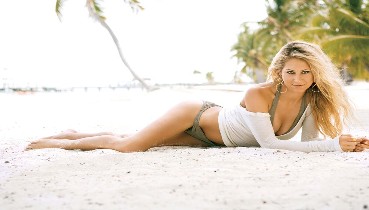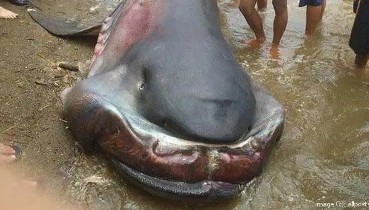

Meet the Bashkir Curly Horse!
 When Nevada rancher Peter Damele and his father first discovered wild horses with curly coats grazing near his land in the Great Basin, they were mystified. Where had these unusual horses come from? More than 100 years later, equine experts still don’t have the answer to that question.
When Nevada rancher Peter Damele and his father first discovered wild horses with curly coats grazing near his land in the Great Basin, they were mystified. Where had these unusual horses come from? More than 100 years later, equine experts still don’t have the answer to that question.
The Dameles began capturing curly-coated horses from the Nevada range at the turn of the 20th century and continued breeding them for their own use well into the 1960s. The horses’ thick coats and amenable dispositions made them especially suitable for ranch work during the tough Nevada winters.

In 1938, when a photo of a curly-coated horse from Bashkir, Russia, was published in Nature magazine, and later reproduced by illustrator John Hix for a print cartoon, the Dameles dubbed their horses “Bashkir Curlies.” Although researchers have not been able to confirm a genetic link between curly horses in America and modern horses in Russia, the Bashkir moniker has remained.
In 1971, curly horse admirers who had joined the Damele family in keeping these unusual equines started the American Bashkir Curly Horse Registry in an effort to preserve the breed. Owners of these horses were asked to list the characteristics they found unique to the Bashkir Curly, and in doing so, discovered some interesting features common to the breed.
They learned that Bashkir Curlies come in pinto and Appaloosa patterns, as well as many common horse colors. They also seem to have conformation similar to the Morgan horse. They are medium in size, have a calm eye and strong hooves, and some are even gaited, moving with a running walk.
The breed’s curly coat is its most distinctive feature, and it comes in different types of curls. These horses also have double manes that split down the middle, with curly ringlets hanging on both sides of the neck.
Their curly winter coat sheds out completely by summer, leaving it wavy or even straight until the curls come back in the fall. And, interestingly enough, Bashkir Curly coats seem to be hypoallergenic.
Mysterious” is the one word everyone in the horse world can agree upon when discussing the origins of the unusual, curly-coated American Bashkir Curly Horse, also referred to as North American Curly, American Curly, or simply the Curly Horse. Horses with curly coats, depicted as far back as 161 AD in the artifacts of early China, suggest these modern day wonders are most certainly descendants of an ancient breed.
The name “Bashkir” was adopted in the late 1930s when an image of a curly-coated horse from Bashkortostan, Russia was published in the 1938 March issue of Nature Magazine, in a feature titled, “The Evolution of the Horses.” While further research indicates Russian horses with curly coats were most often those of the Lokai breed found in the Taijikistan region of Russia, the name Bashkir stuck and is perhaps most widely used today.
The arrival of the breed in North America is equally shrouded in mystery and speculation. Some believe these horses were among those who crossed the Bering Strait land bridge during the last ice age, though fossil evidence does not support this hypothesis. Others entertain the possibility that Spanish conquistadors brought the curly-haired horses up from South America, but this, too, has not been proven.
 Another premise traces their arrival back to Russian colonists, who immigrated with the intent of settling and farming America’s Northwest Territory in the 1700s. Some purport the colonists brought the Curlies with them, later abandoning the horses–along with their farming dreams. What is known, is that Curlies have been in North America since the early 1800s. Numerous Indian pictographs (records consisting of pictorial symbols) from 1801-1802 illustrating the “Winter Counts,” note the Sioux had stolen a number of curly-haired horses from the Crow at the Standing Rock-Cheyenne River Reservation.
Another premise traces their arrival back to Russian colonists, who immigrated with the intent of settling and farming America’s Northwest Territory in the 1700s. Some purport the colonists brought the Curlies with them, later abandoning the horses–along with their farming dreams. What is known, is that Curlies have been in North America since the early 1800s. Numerous Indian pictographs (records consisting of pictorial symbols) from 1801-1802 illustrating the “Winter Counts,” note the Sioux had stolen a number of curly-haired horses from the Crow at the Standing Rock-Cheyenne River Reservation.
What we do know is that this rare and beautiful breed (as of May 2005 there were just over 4,000 worldwide) arrived in North America and ended up roaming with herds of wild mustangs.
The Curlies’ survival in modern times can be traced directly back to 1898, with their discovery by a ranching family in Eureka, Nevada. While out checking cattle in the remote high country of the Peter Hanson Mountains, John Damele and his sons caught sight of three unusual looking horses running among the mustangs. These horses had tight, curly ringlets covering their bodies.
Though intrigued, it would not be until 1931 that they would catch one of the curly-haired equines. When they did, they broke it and sold it. A devastatingly cold winter in 1932 would bring their attention back to the curious equines. While re-gathering their ranch horses that had been wintered out, they found all had perished in the brutal weather.

Recommended Videos
 Thousands of rare 'ice eggs' found on beach in Finland96 views
Thousands of rare 'ice eggs' found on beach in Finland96 views A Gorilla With A Pink-White Finger Because Of Lack Of Pigmentation On Her Hand3534 views
A Gorilla With A Pink-White Finger Because Of Lack Of Pigmentation On Her Hand3534 views-
Advertisements
 Top 10 Most Stunningly Birds in the World...13607 views
Top 10 Most Stunningly Birds in the World...13607 views Artist Uses Makeup To Turn Into 15 Nightmarish Monsters196 views
Artist Uses Makeup To Turn Into 15 Nightmarish Monsters196 views Wildlife Photographer Captures A Rare Yellow Penguin97 views
Wildlife Photographer Captures A Rare Yellow Penguin97 views Photographer Captures the Otherworldly Beauty of the Arctic35 views
Photographer Captures the Otherworldly Beauty of the Arctic35 views 30 Most Beautiful Black Women in the World17308 views
30 Most Beautiful Black Women in the World17308 views A Wunderpus octopus (Wunderpus photogenicus) in its larval stage.1737 views
A Wunderpus octopus (Wunderpus photogenicus) in its larval stage.1737 views



